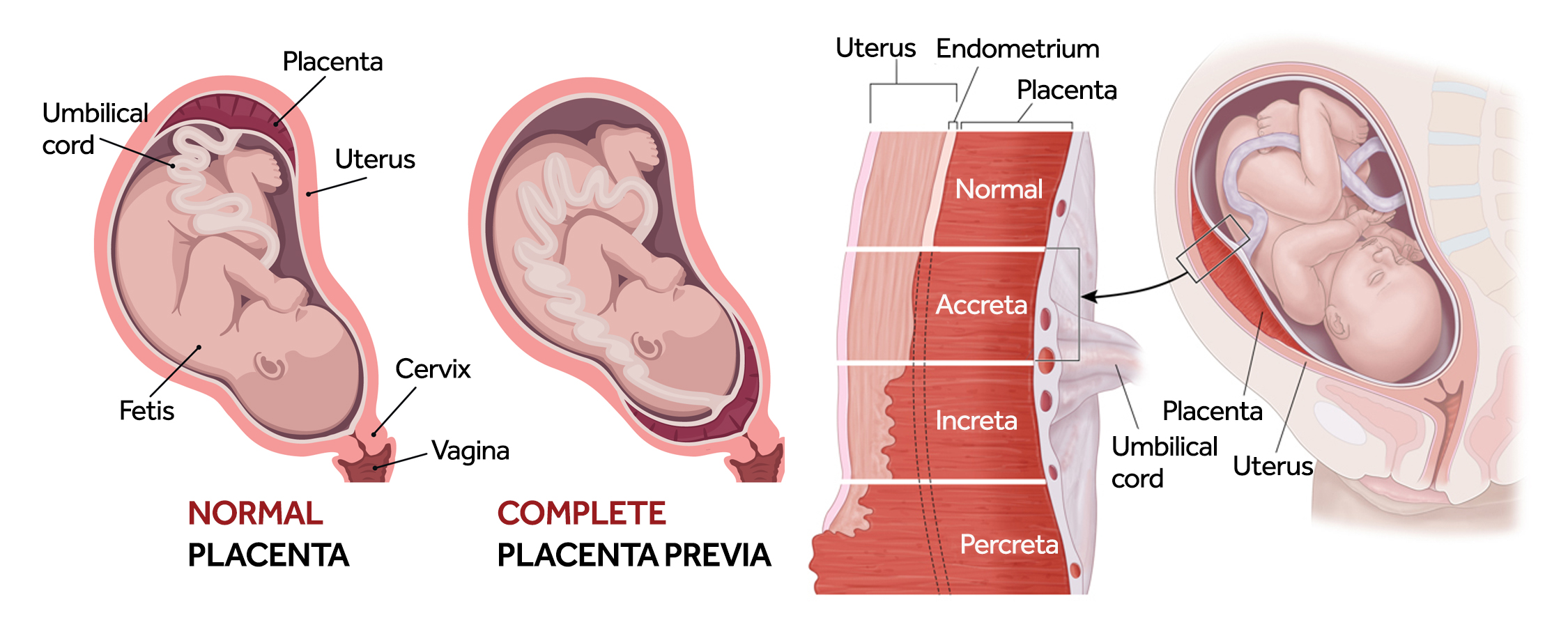
What is a Placenta Accreta Spectrum (PAS)?
The placenta is a crucial organ that develops in pregnancy and attaches to the wall of the uterus (womb) without growing into it. Blood passes from the mother through the placenta delivering oxygen, nutrients, and important hormones via the umbilical cord to the baby. It is the baby’s lifeline throughout pregnancy. Regardless of whether during a vaginal or cesarean delivery, the placenta is expected to detach and deliver a few minutes after delivery of the baby.
However, in some mothers either all or part of the placenta grows into the uterus and cannot detach after delivery. If not treated properly, the mother can have significant blood loss (hemorrhage) after delivery. This rare, potentially life-threatening condition is called Placenta Accreta Spectrum (PAS). It is referred to as a ‘spectrum’ due to the range of severity that corresponds to the depth the placenta is growing into the uterus and surrounding organs. The different types of Placenta Accreta Spectrum disorders include:
Placenta accreta - when the placenta grows into the lining of the uterus (most common)
Placenta increta - when the placenta grows into the wall (muscular layer) of the uterus
Placenta percreta - when the placenta grows through the wall of the uterus, occasionally into nearby organs such as the colon or bladder.
Our doctors have specific expertise in the care of placenta accreta spectrum and other placental problems including:
- Placenta previa - when the placenta is in the lowest part of the placenta and covers all or part of the opening to the cervix
- Placental abruption - when the placenta separates from the inner wall of the uterus before the baby is born

Placenta accreta graphic provided by BabyCenter
Who is at risk for Placenta Accreta Spectrum (PAS)?
The estimated incidence (how often it happens) of Placenta Accreta Spectrum (PAS) pregnancies has quadrupled since the 1980s, increasing from 1 in 1250 births to 1 in 272 births. As the overall cesarean delivery rate in the United States has continued to rise, the rates of PAS have risen in parallel. Certain women are at higher risk for PAS:
- Women who have had previous cesarean birth
- Women with previous uterine surgery (example: myomectomy, dilation & curettage)
- Women over the age of 35 years
- Women who have had multiple previous pregnancies
- The placenta position/location in the uterus - risk increases if your placenta covers your cervix (placenta previa) or sits on the lower portion of your uterus
Risk of Developing Accreta after Previous Cesarean Birth*
| WITH placenta previa | WITHOUT placenta previa | |
| One prior cesarean birth | 3% | 0.03% |
| Two prior cesarean births | 11% | 0.2% |
| Three prior cesarean births | 40% | 0.1% |
| Four prior cesarean births | 61% | 0.8% |
| For or more prior cesarean births | 67% | 0.8% |
What are symptoms of Placenta Accreta Spectrum (PAS)?
Most of the time, a woman has no signs or symptoms of PAS. Occasionally, women may experience bleeding during the second half of pregnancy.
How can Placenta Accreta Spectrum (PAS) be diagnosed?
Placenta accreta is sometimes detected during a routine ultrasound, but often a specific ultrasound is done to screen women who have specific risk factors (e.g. previous cesarean or placenta previa). If PAS is suspected, a magnetic resonance imaging (MRI) is performed to evaluate how deeply the placenta is invading the uterine wall or surrounding structure (like bowel or bladder). Once PAS is confirmed, the pregnancy is then considered high-risk and obstetric care is transferred to the Maternal Fetal Medicine (high risk obstetric) team.

